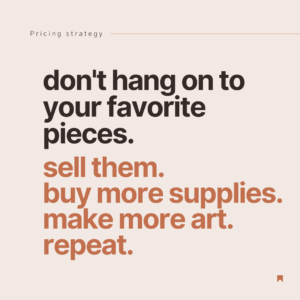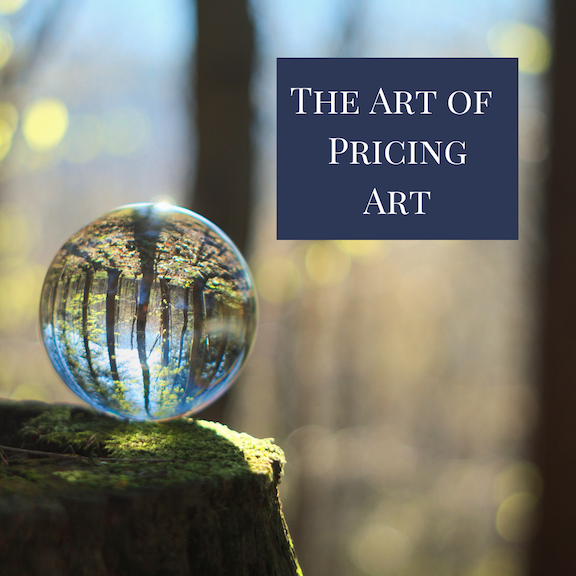What artists and collectors need to know about the valuation of art.
I am frequently asked about the price of art. Beginning artists want to know how to get started when they don’t have a track record and established artists wonder if their prices are where they should be. Conversely, collectors want to know how an artist came up with his or her prices and if those prices are appropriate. Thus, a blog to help you do the numbers. Lots to cover, so let’s jump in.
Check for a Pulse
If you are a living artist or a collector, presumably living, and you’re wondering how art is priced, this section is for you.
(Dead artists and deceased collectors, please feel free to skip ahead. You earned it.)
Artists, god love ya, but you can be all over the map with pricing and it’s making my head spin. It’s also causing collectors to wonder if what they’re buying is worth it.
Collectors are buying a product–yes, a work of art they have fallen in love with–but it’s a luxury, which is why they compare your prices to other things they also need or want. Once collectors start doing some mental math and making comparisons, you can bet they’re going to second guess you and themselves.

So, how do you keep collectors from second guessing themselves right out of a purchase?
Excellent question.
Do you need new friends?
I’m sounding like a broken record here, but the art world is famously opaque. Let’s face it, we like obfuscation. It’s, well, arty. And fun. Really fun. Which is why I love writing this blog. The art world provides an endless well of secrets from which to draw.
Artists, here’s the deal. Collectors are smart people. We know they’re smart because they like art. Their friends know they’re smart, too. Their friends are also smart, but not necessarily interested in art, which means they’re not as smart as collectors. Are you with me?
So, these non-collector friends try to hide the fact that they don’t care about art and would rather spend their money selfishly on themselves (kidding…kind of…actually, they’re not reading this so, not kidding). And, non-collectors who haven’t invested the time and energy into learning about art try to hide this lack of savvy by making fun of the art that their collector friends have chosen.
Not cool. But it happens all the time.
Apart from the obvious solution–get new friends–the collector needs access to more knowledge about you and what you’re up to as well as some solid intel when it comes to how you price your work.
Ground Rules
In a nutshell, please adhere to the following:
1. DON’T price by the amount of time it took you. Some pieces take a ridiculous amount of time, others just flow. That’s the life of an artist; you learn to take the victories with the struggles.

2. DON’T price by how much you love the thing you just created. You will create something you love even more. Maybe not tomorrow or next week, but you will. Let it go and trust in the process.
3. DON’T price based on what other artists your same age or socio-economic or education level are pricing their work at. This isn’t a race. Wish them well and get back to work.
4. DO, for the love of Pete, price consistently by the square inch. (Dead artists, hang on, I haven’t gotten to you yet.)
Ugh! Math...
Yeah, I hear ya, you went to school for art not math. Don’t worry, we’re not getting fancy here.
Step 1. Figure out the square inch, which is height x width.
8 x 10 = 80 square inches
Easy peasy.
Step 2. Assign a dollar amount. (I’ll help you figure this out next.)
Here’s what happens when you pick one amount and stick with it for every size painting you create.
8 x 10 inches = 80 x $5/sq in = $400
16 x 20 inches = 320 x $5/sq in = $1,600
30 x 40 inches = 1200 x $5/sq in = $6,000
The small ones are a little low and the big ones are kind of high.
The Sliding Scale
When you adjust by assigning the smaller works a higher square inch price and reduce that amount as you get bigger, it starts to feel more equitable. And, for lots of artists, this gets a little closer to assigning an hourly wage to the work, since creating art takes time no matter what size you’re working on.
8 x 10 inches = 80 x $10/sq in = $800
16 x 20 inches = 320 x $7/sq in = $2,240
30 x 40 inches = 1200 x $5/sq in = $6,000
Where to Start When You're Starting
My very best advice for those of you who haven’t started selling your work (and no, sales to friends and family don’t count):
Price it low, sell it fast, and use the proceeds to buy more supplies.
Here’s why. When you over-value your early work–yes, it took you a long time and you’re proud of the breakthrough pieces–buyers don’t get why a novice’s work is so expensive relative to artists who’ve been in the market a lot longer.
The next thing you know, the collector is making comparisons. End result: no sale.

Same with dealers and curators. If you price your work too high, we evaluate your work based on what’s out there, but when we check out your accomplishments and don’t find any, we know you have an unrealistic and overinflated sense of your work, and will take great offense if we even brooch the topic of prices. So, we take a hard pass.
The other really, really important thing about selling work at affordable prices when you are just starting out is that you won’t have stacks of inventory piling up. This means you won’t be hanging on to that one amazing work that is your all time best ever. Because when you hang on to the best ever thing you’ve made, it will sit in your studio and taunt you. It will whisper: You’ll never do anything better. Give up. It’s useless to continue.
When to give yourself a raise
There are a number of factors to suss out before raising your prices.
1. Consider taking a 10% increase every 1-2 years. This is a small enough amount to not be readily noticed and scare people off, but big enough that collectors can see that their “investment” in you is going up.
2. Check the economic forecast. If we’re headed into a recession, maybe hold off another year.
3. Know your client base. If you’re clients are in the tech industry, for example, consider how things are going in their world. If everything is booming, no matter what the economy is doing, you might be ok with a price increase.

NOTE: If you never take a price increase, you could see your collector base become as stagnant as your prices. Keeping your prices at the same rate may feel safe, but in the long-run, that security blanket will drag you right into obscurity. The market wants to see a recognition of your growth and success in the form of a price increase, so take it.
Can I adjust for gallery commissions
That’s a big NO.
Think of your work and the prices you command like any other commodity. There is a price it trades for, that price is listed in shows, on wall tags and websites, which means it’s verifiable. And collectors WILL verify your prices. If they see prices are higher in one place and less elsewhere, two very bad things happen.

First, buyers will go around your galleries and exhibitions and call you directly. Dealers always hear about this and will kick you out of their world faster than you can say, “Oh, crap, Rose warned me about this!” On top of that, now you’re in the position of having to haggle and sell yourself when you really should be in the studio making art.
Second, you have devalued your work to the lowest number listed anywhere your work is for sale. Why would anyone pay more?
Remember, collectors don’t always know why something is priced as it’s priced, but they are smart enough to know when things look fishy. And there are simply too many terrific artists who are being consistent with their prices; collectors don’t need to go through the hassle of figuring out a pricing system that doesn’t make sense.
Framing and other considerations
Instead of adjusting your prices to the frame, select frames that are roughly 10-15% of your retail price for that work. For example, a $1,000 painting should have a frame that cost you $100-$150.
Shipping…yeah, that’s a tough one. And now most shows won’t pay for work coming to them or going back to you. Consider investing in air float crates. They are pricy, but you can reuse them many times. Plus they weigh less than wooden crates, which are unwieldily and cost ridiculous amounts of money to send. (And often arrive damaged because delivery people drop them or run fork lifts through them….)
Buying from the dearly departed
COLLECTORS, if you’ve dipped a toe into the deceased art market, you know all bets are off when figuring out pricing.
I covered some of this in my last blog, Collect Like a Pro, which gave you all tips and tricks for navigating the market. Basically, when art hits the secondary market, the prices are determined by a few factors:
- Supply and demand
- Importance of that work amid the artist’s entire body of work, i.e. was it a seminal piece that marked a major turning point in the aritst’s career?
- Quality of the work–is there any damage, has it been conserved, etc.
- Provenance–who owned it and whether that collection was important.
- Exhibitions, awards, honors, etc., for the work and the artist.
Collectors who are considering buying historically significant works would be best advised to work with an art consultant or go through a trusted gallery. There are a LOT of fakes out there. An advisor can help you find and buy work that is within your budget and has the pedigree you want for your investment.
An Art Afterlife insurance policy
ARTISTS, this is important. When you’re gone, dealers and collectors will be the judge and jury of your work using the above criteria. Remember when I said not to price things based on how much time it took you or how much you liked a work of art? It still doesn’t matter…right now; what does matter is that you keep a record of those breakthrough works and why they were important. Also, record info about your process and who you were palling around with at the time.
The things that hurt the secondary market valuation of art:
- Bad auction sales
- Lack of visibility in national shows
- No catalogues or other critical writing about your work (i.e., astute writing by authorities in the art world)

Here are some things to do now to support the valuation of your work and boost your prices while you can enjoy the dough:
- Write things down about work that is important to you.
- Try to get your best work into major exhibitions so there is a record of those pieces.
- Work with galleries to get prominent collectors to purchased important works.
- Seek museums to collect your work, even if that means a discount or donation.

12 thoughts on “Making Sense of the Price of Art”